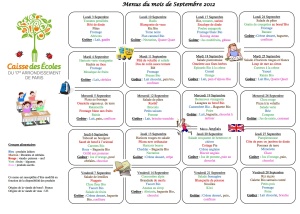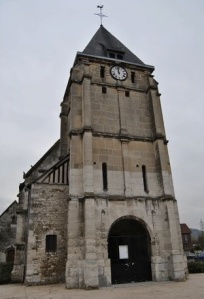Not all French people live in charming villages in Provence with a local market just around the corner. Many live in big cities, with long commutes, dual working couples, the usual pressures of modern life. School lunches are even more crucial here, feel the French, as most children don’t have the option of going home for lunch (as some still do in small villages).
School lunches are paid for locally — there is no equivalent of the National School Lunch Program (that’s right-no subsidies, no bulk commodity purchases). Everything is decided and paid for locally; parents pay part of the cost of lunches (typically about 3 Euros or $4 dollars), and local taxes cover any remaining costs. That’s why it’s so interesting so look at lunches in different communities in France-they really do vary tremendously.
This week we’re in the centre of France, in the town of St Etienne: best-known for its role in the arms industry (it was even renamed ‘Armeville’ during the French Revolution!). In addition to arms manufacturing, it was also a big mining town. It’s also one of the first cities in France to decide to convert to organic food for school lunches. As of January 2012, 70% of the food served is organic. And by 2014, 100% will be organic. And most of the food is sourced locally (cabbage and carrots in winter, and only a rare serving of tropical fruit).
And it didn’t turn out to be as expensive as you might think. Eliminating expensive food items (like pineapple in winter) saved some money, and long-term contracts with local organic suppliers reduced costs. School lunches in St Etienne cost between 1 and 4.5 €uros (prices are set on a sliding scale, depending on family revenue)-or between $1.3 and $5. In fact, when the city decided to introduce organic food, it lowered the average cost of meals by 10% (20% for lower-income families). The number of children eating meals at the cantine rose (to 2500 per day).
Regular surveys indicate a high level satisfaction: 85% in summer, and 75% in winter (must be the cabbage). The menus do look delicious….
As usual, the meals follow a four course structure: vegetable starter; main dish with vegetable side; cheese course; dessert. All meals are served with fresh baguette (eaten plain, usually one piece per child!) and water. No flavoured milk, juice, sports drinks, or pop. No vending machines. No fast food or junk food. Food for thought!
Monday, June 18th
Organic beets with shallot sauce
Roast chicken with organic lentils
Dairy: Organic ‘Petit fondu‘ (a soft cheese, somewhat like brie)
Dessert: Seasonal organic fruit (at the moment, peaches, cherries, and apricots!)
Tuesday, June 19th
Organic fusili salad
Organic omelette and organic steamed spinach
Dairy: Plain yogurt (organic) with sugar
Dessert: Seasonal organic fruit
Wednesday, June 20th
no school
Thursday, June 21st
Organic coleslaw salad
Lamb meatballs with tajine (Moroccan) sauce and organic couscous
Dairy: Tomme (a mild, hard cheese from the Alps)
Dessert: Vanilla cream
Friday, June 22nd
Cantaloupe
Fish filet with sautéed organic vegetables and organic potatoes
Dairy: Organic camembert
Dessert: Organic compote (fruit sauce)
You can tell I’m rather enthused about this menu, right? They demonstrate the power of community-parents, teachers, local government working together. They also demonstrate a spirit of solidarity-because meals are priced on a sliding scale, everyone gets a heathy meal.
Food for thought.
This blog post is part of my French Kids School Lunch Project. Every week, I post the school lunch menus from a different village or town in France, where three-course, freshly-prepared hot lunches are provided to over 6 million children in the public school system every day. These meals cost, on average, $3 per child per day (and prices for low-income families are subsidised). My hope is that these menus (together with my other blog posts about the French approach to kid’s food) will spark a conversation about what children CAN eat, and how we can do better at educating them to eat well.
Like this:
Like Loading...


